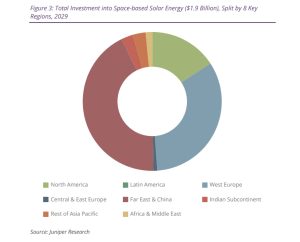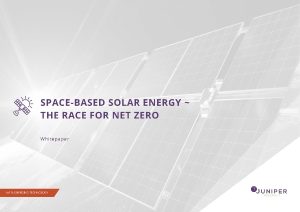Total investment in such energy – defined as the transmission of solar energy harvested in space for terrestrial use cases – will then grow again to $36.1bn by 2035, estimates the market analyst.
The increase, in spending by space vendors and agencies, will mainly be driven by the need for renewable baseload energy (the minimum amount of energy required to be provided to the grid), it highlights.
 The report is titled ‘Space-based Solar Energy Future Opportunities: 2024-2035’ and covers an area that hasn’t proved economically viable to date but in which governments and companies are increasingly showing interest.
The report is titled ‘Space-based Solar Energy Future Opportunities: 2024-2035’ and covers an area that hasn’t proved economically viable to date but in which governments and companies are increasingly showing interest.
Juniper Research anticipates that, in order to keep pace with future demand, global net electricity production must exceed 43,000 TWh in 2035.
Baseload
“Space-based solar power offers a resolution to the output variance of terrestrial renewable electricity sources, and thus concerns about meeting baseload power thresholds,” writes analyst Alex Webb. “By harvesting solar energy in space, space-based solar energy systems
can operate at baseload 24 hours a day, 365 days a year; guaranteeing demand for electricity is met, whilst meeting net-zero targets.”
“Moreover, GEO orbit receives more than 100 times the amount of energy necessary to meet global electricity demand in 2050, meaning not only is space-based solar energy more dependable than terrestrial sources, but it also has the capacity to meet global electricity demands.”
Space-based solar energy
The report dataset contains 5,000 market statistics over a 11-year period, says Juniper, and report includes in-depth forecasts for 12 countries as well as market analysis.
Specifically, it covers, wireless power transmission in space, solar power satellite design (CASSEOPeiA, SPS ALPHA, Tethered SPS), and autonomous distributed space systems, and vendors from Airbus to Virtus Solis.
You can find out more about the research online.
See also: Oxford PV claims record for perovskite-silicon solar panel

